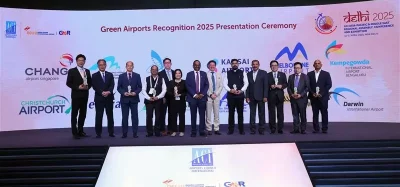Fraport focuses on long-term applied environmental protection
- Like
- Digg
- Del
- Tumblr
- VKontakte
- Buffer
- Love This
- Odnoklassniki
- Meneame
- Blogger
- Amazon
- Yahoo Mail
- Gmail
- AOL
- Newsvine
- HackerNews
- Evernote
- MySpace
- Mail.ru
- Viadeo
- Line
- Comments
- Yummly
- SMS
- Viber
- Telegram
- Subscribe
- Skype
- Facebook Messenger
- Kakao
- LiveJournal
- Yammer
- Edgar
- Fintel
- Mix
- Instapaper
- Copy Link
Posted: 1 August 2008 | Dr. Peter Marx, Fraport, Vice President of Environmental Management, Fraport AG | No comments yet
Global – Ecological – Sustainable. The corporate environmental strategy is confronted with a new challenge with Fraport’s expansion. Successful approaches for the airport’s central environmental aspects – aircraft noise and climate protection – can only be developed and implemented within a sustainable strategic approach.
Global – Ecological – Sustainable. The corporate environmental strategy is confronted with a new challenge with Fraport’s expansion. Successful approaches for the airport’s central environmental aspects – aircraft noise and climate protection – can only be developed and implemented within a sustainable strategic approach.
The foundations of the current Fraport Environmental Strategy were declared in the current Fraport vision, in which three corporate goals were derived: value creation, strong performance and sustainability. The goal of sustainability has gained increased importance over the last years; this is how Fraport came to join the Global Compact initiative. It was founded by the United Nations and obligates participating companies to contribute to a sustainable and fair world market by exercising universal human rights and environmental principles. An organisational consequence stemming from this is the planned formation of a corporate-wide sustainability board.
Environmental protection at Fraport can be found under sustainability in the context of the strategic specifications of the corporate goals, which bestows the environmental protection activities with a special characteristic; these are designed for the long-run and conform with ecological criteria. This means that Fraport must withstand a knowledgeable external assessment and is to be, consequently, transparently planned. Fraport’s Environmental Management has fulfilled the demands of the Eco-Management and Audit Scheme (EMAS) standards since 1999 and ISO 14001 standards since 2002 at Frankfurt Airport.
Fundamental stipulations to the sub-goal environmental protection, which are vital to Fraport’s environmental strategy, are found in the Fraport vision:
At all Fraport locations, we are particularly committed to environmental protection and compatibility in order to conserve natural resources. Our commitment to environmental excellence exceeds legal requirements. We consider environmental protection an issue that goes beyond airport boundaries.
Two aspects of special importance are:
- Environmental protection at the airport always concerns the surrounding areas that are affected by environmental impacts from air traffic, such as aircraft noise
- The fundamental commitment to environmental protection explicitly encompasses all corporate locations.
A direct line leads to the Fraport Group’s Extended Environmental Policy from spring 2008, in which the most important matters for the corporate-wide environmental protection are named. It states the following:
The Environmental Policy Statement has been formally adopted and signed by the Board of Fraport AG. It will be communicated to our staff and business partners.
In developing and operating all our business locations, Fraport AG is committed to managing all airport activities in an environmentally responsible manner. We will strive to create and protect a safe living environment at our business locations by providing our employees with safe working conditions.
Maintaining, developing and systematically improving our system of environmental management will support the compliance with the applicable laws and regulations and lead to a continuous improvement of our environmental aspects.
We will undertake initiatives to promote greater environmental responsibility by training our employees and providing awareness programs for the employees at our business locations.
Our business will support a precautionary approach to environmental challenges, respecting the principle that our environmental programs will be cost-effective, economically viable and sustainable.
We will encourage the development and diffusion of environmentally friendly technologies by applying environmental criteria when selecting goods and services.
We will provide an annual environmental report of our environmental activities, making the information available to both employees and the community.
These corporate-wide environmental protection goals are to be implemented at all airports and various other sites at which Fraport has shares or operative management contracts. Aside from Frankfurt Airport, the Frankfurt-Hahn and Hanover airports in Germany as well as the airports in Lima, Cairo, Delhi, Antalya, Burgas and Varna count towards these. In the future, the new airports in Dakar and Xian Xianyang in China will also be included. Several airports have already received ISO 14001 certifications and others are being prepared. Fraport is involved in the Global Reporting Initiative (GRI) and advocates the development of a worldwide accredited industry standard for reporting and evaluating sustainability aspects in the air traffic industry.
The functional principle can be summarised in two terms, despite the complexity of an environmental strategy aimed at sustainability: individual responsibility and transparency.
Aircraft noise: a balanced approach
Even though climate protection is the focus of public awareness, aircraft noise is still the most important environmental aspect at the majority of airports. Fraport Environmental Management at the Frankfurt Airport applies a balanced approach when it comes to aircraft noise. The superior goal for this sector is:
In view of the predicted growth at Frankfurt Airport, Fraport will strive to influence the main actors as to decouple airborne noise in relation to the increase in air traffic.
Technology, processes and measures needed to attain this goal are being discussed, developed and implemented in all large airports around the world. Airports Council International (ACI), an organisation in which airports worldwide have aligned, is responsible for this. The airport representatives discuss their environmental strategies and the associated measures and experiences in the ACI World Environment Standing Committee. ACI is strongly anchored in the civil aviation organisation from the United Nations, namely the International Civil Aviation Organisation (ICAO). This process of discussing and exchanging experiences has caused the environmental strategies of the majority of airports and airport operators to be similarly formulated and the means of implementation to be similarly applied. ACI’s balanced approach regarding aircraft noise coincides with ICAO recommendations:
- Reduction of noise emissions and noise sources, primarily airlines and aircraft
- Noise optimised residential and route planning – no settlement of areas with significant exposure levels and rerouting of takeoff and landing routes away from densely populated areas
- Noise optimisation in operational processes, such as the landing and take-off (LTO) cycle of aircraft in the air, as well as ground procedures
- Introduction of suitable regulations, such as special night flight regulations
All of these approaches are followed in Frankfurt as well as all other corporate airports; however, an effective aircraft noise management is built on the system partnership of the entire air traffic industry, incorporating the airports, airlines, air traffic control and regulatory authorities, as well as the aircraft and engine manufacturers, indirectly.
In the focus of the practical activities for noise avoidance and reduction at the Frankfurt Airport are both passive and active noise abatement. Active noise abatement includes approach procedures and noise optimisation of flight paths, so that as few residential areas as possible are afflicted by aircraft noise. The first low noise approach procedure was tested and implemented in Frankfurt in 1972, the ‘low drag – low power’ procedure. Nowadays, this is a standard procedure at all civilian airports worldwide. The further development of this procedure has led to the Continuous Decent Approach (CDA), allowing for the aircraft to land from great heights with minimal engine use. Since this procedure requires a large distance to be maintained between the individual aircraft, it is only implemented at night. Unlike the landing approach during which the aircraft must follow a radio beam, pilots are able to vary their flight routes from the start with consent from air traffic control to avoid populated areas. Groundbreaking efforts were made in Frankfurt concerning the close cooperation between the airport, airlines and air traffic control.
The active noise reduction procedures are complemented by the passive noise reduction procedures. Over 8,000 households and public facilities – schools, nurseries, retirement homes – near the Frankfurt Airport particularly affected by aircraft noise were fitted with sound insulated windows, roller shutter housings and soundproof ventilators. The main goal in these measures is to provide residents with undisturbed sleep from aircraft noise.
An indispensable part of the noise protection activities of any kind is reliable data. These are collected by Fraport in Frankfurt with the aircraft noise monitoring system. The collection of reliable data and the optimisation of the monitoring system to state of the art technology is a priority at all airports in the corporation.
Climate protection: reducing CO2 emissions
CO2 is the most important and decisive greenhouse gas in terms of global warming. An effective climate protection must thus be developed, aimed at drastically reducing CO2 emissions worldwide. The part that the air traffic industry plays in this context is often exaggerated. The latest surveys and projections suggest that the air traffic industry’s share in global CO2 emissions is approximately two to four per cent. Nevertheless, air traffic is expected to grow in the future and consequently there will be a rise in associated CO2 emissions. The air traffic industry decided to take on this responsibility and agreed, at ACI’s 3rd Aviation and Environment Summit, to take the necessary measures to reduce negative influences on the environment and simultaneously aid efforts for a sustainable development of their global networking. In addition, the declaration, also signed by Fraport, appealed to governments of the represented countries to support the development of a global emissions management program through ICAO.
If one considers the air traffic procedures as a whole, then one will see that airplanes are the largest source of emissions while in the air. However, airports also contribute to CO2 emissions with mobile work machines, equipment, all kinds of vehicles, electricity consumption, heating, cooling, delivery and service traffic. ACI recommends an integrated and long-term strategy for airports. One primarily sees the following possibilities:
- Promotion of CO2 -reducing activities in areas that are subject to the airports direct influence and can be effectively swayed by them
- Starting points are primarily the LTO-cycles as well as the aircraft taxiing traffic and the emissions from service vehicles on the apron
- A further area is the increase in airport building energy efficiency, making a significant emissions reduction possible
Fraport is confronting this challenge with the current development of a ‘climate protection strategy 2020’, which is to be initially implemented in Frankfurt. However, the reduction of the CO2 output at the other airports within the corporation is being worked on feverishly; this is driven by the rising energy prices, a decisive economic factor for the reduction of CO2 emissions.
Sustainability: a key factor in successful growth
Sustainability as a corporate goal at Fraport implies focusing the business strategy on long-term economic, social and ecological stability. The admittance of Fraport’s stock into the most important global sustainability indices – FTSE4Good, DJSI STOXX, DJSI World, SAM Bronze Class 2008 – confirms that the strategy was successfully implemented. Fraport’s Environmental Management plays a vital role in this. The task is to design the business operations in such a way that the strategic business units can run them as environmentally friendly as possible. The focus of the activities is the sparing use of natural ground resources, water and air, as well as the increase in energy efficiency, careful interaction with biodiversity, and the avoidance of emissions – both pollutants and greenhouse gases. In addition, a central aspect for Environmental Management is aircraft noise, which is seen by many residents as the airport’s greatest environmental impact. The methodical basis for the Fraport Environmental Management is the Environmental Management System (EMS), which makes the basis for the airport’s validation by EMAS and the certification of Environmental Management by ISO 14001 possible due to systematic work and a high standard of transparency.
An Environmental Management System is, according to ACI, the most important requirement for sustainable environmental management. That is why the adoption of an Environmental Management System is recommended at all airports. Experiences at Frankfurt show that an Environmental Management System at a major airport is not a static structure, but a process that must always be adapted to the conditions and demands. The key activities of the Fraport Environmental Management are on the one hand the further development of the EMS at Frankfurt Airport and on the other hand guiding the implementation and development of an environmental system at other airports within the corporation. Lima, Frankfurt-Hahn and Hanover already have the respective systems. Cairo, Delhi, Antalya, Varna and Burgas are currently working in project teams to create an EMS.


















